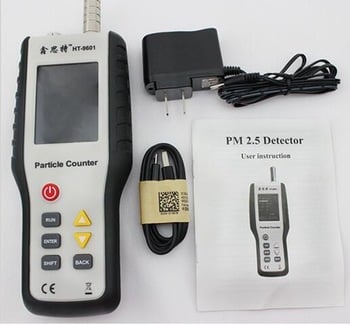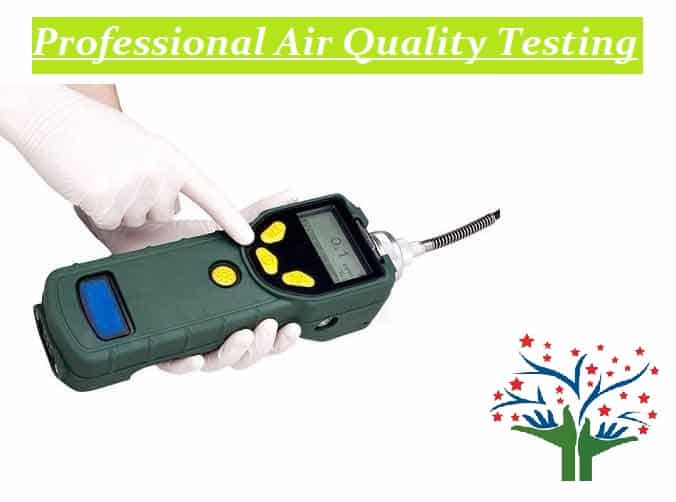Professional Air Quality Testing
Professional air quality testing involves the systematic analysis of indoor and outdoor air to detect pollutants such as particulate matter (PM2.5, PM10), volatile organic compounds (VOCs), carbon monoxide (CO), nitrogen oxides (NOx), sulfur dioxide (SO2), mold, and allergens. Experts use calibrated instruments and scientific methodologies to ensure accurate results, helping businesses and individuals maintain a healthy, breathable environment.
Professional Air Quality Testing is process of Sampling and analyzing the results of ambient or indoor air in laboratory by professionals using scientific methods.
Good Air Quality is what everyone is yearning for, especially these days! But, how can we tell if Air around us is of Good quality or Bad Quality?
This is a question many have and the answer to this is simply by having an air quality test performed. By taking the help of professionals we can have an assessment done of the air quality around us and get an insight about what we are dealing with and how to get rid of Bad air quality. Sounds great doesn’t it?
Air quality testing is a critical aspect of maintaining a safe and healthy environment, particularly in urban areas and industrial settings. Poor air quality can lead to various health issues such as respiratory problems, heart disease, and other long-term conditions. Professional air quality testing helps identify harmful pollutants, ensuring compliance with safety standards and improving public health. Here’s a detailed look at the process and importance of professional air quality testing.
With the help of professionals we can get closer to our desire for Good Air Quality!
Why Air Quality Testing is Important
Air quality directly affects the well-being of individuals, especially those with pre-existing conditions like asthma or allergies. Inadequate indoor air quality can lead to sick building syndrome, where people in a particular building experience health issues due to air contaminants. Similarly, outdoor pollution from industrial activities, traffic, and construction can affect larger populations.
Identifying pollutants through testing allows governments and organizations to take corrective measures, such as improving ventilation, reducing emissions, or using air purification systems.
Common Indoor Air Pollutants and Their Effects
Indoor air pollution is often worse than outdoor pollution due to limited ventilation. Some common indoor air pollutants include:
- Volatile Organic Compounds (VOCs): Found in paints, furniture, and cleaning supplies, these can cause headaches, nausea, and even long-term neurological issues.
- Particulate Matter (PM2.5, PM10): Generated from cooking, smoking, and dust, these fine particles can cause lung diseases and cardiovascular problems.
- Mold & Mildew: Grows in humid areas, leading to allergies, asthma, and respiratory infections.
- Carbon Monoxide (CO): A deadly gas emitted by faulty appliances, heaters, and fireplaces.
- Radon Gas: A naturally occurring radioactive gas that can lead to lung cancer if present in high concentrations.
Professional Air Quality Testing
Air quality testing refers to monitoring and analysis of pollution level thus determining the quality of air. Deterioration of air quality is caused due to many factors and it is thus basically differentiated into;
There are other types of air quality test which are more specific towards industries and are conducted by highly trained professional namely stack emission testing, DG set emission testing, fugitive gases emission testing, etc.
Types of Professional Air Quality Testing Methods
Professionals use different air quality testing methods depending on the environment and pollutants being measured. These include:
A. Traditional Laboratory Testing
- Gravimetric Analysis: Used for particulate matter sampling.
- Gas Chromatography: Measures VOCs in indoor air.
- Chemical Absorption: Tests for NOx, SO2, and CO.
B. Sensor-Based Air Quality Monitoring
- Handheld Air Quality Sensors: Provide real-time readings of PM2.5, CO2, and VOC levels.
- IoT-Enabled Continuous Monitoring: Used in smart buildings for 24/7 tracking.
Now the Benefits !
A thought may occur to some of you, that why can’t we solely do air quality testing without taking any help from professionals. Well there is no denying that we can do air quality testing, but there will be huge no of limitations with high probability of getting inaccurate test results.
To
acquire accurate test results it is always advisable to get professional’s
help.
The professional will;
- Monitor all parameters which are detrimental to human health with calibrated instruments
- Provide accurate results in short time period
- Provide recommendations required to obtain better Air quality and will guide through to
achieve it. - Businesses and industries that perform regular air quality tests stay compliant with environmental laws, avoiding hefty fines and shutdowns.
- Air testing helps in monitoring pollutants that contribute to global challenges like climate change and ozone depletion, allowing corrective measures to be taken.
- Testing helps improve indoor comfort and productivity by controlling humidity, temperature, and air purity, which are critical for employee well-being.
- Importance of Air Quality Testing for Businesses
- For businesses, poor air quality can lead to employee health problems, reduced productivity, and potential legal liabilities. Regular air testing ensures:
- Compliance with OSHA and EPA regulations to avoid fines.
- Better indoor air quality, leading to higher employee retention and satisfaction.
- Energy efficiency improvements by optimizing HVAC and ventilation systems.
Challenges in Air Quality Testing
- Rapid Urbanization: As cities grow, the number of vehicles and industries increases, making it more challenging to maintain acceptable air quality levels.
- Complex Pollutants: Identifying and controlling complex pollutants, like ultrafine particles and new chemical compounds, require advanced testing techniques.
- Cost and Accessibility: Professional air quality testing can be expensive, especially for small businesses or households, limiting access to high-quality testing equipment.
Having known some benefits which we can avail with help from a professional, let’s see a brief overview of how they conduct air quality testing.
Know what are Indoor Air Quality testing Standards?
Professional Air Quality Testing Procedure
For any type of air quality testing, be it ambient or indoor it is necessary to study the site first. Studying the site and surveying the residents gives a succinct idea about pollutants which may dwell there.
In general the procedure for both ambient and indoor air testing will be as follows;
- Selection of sampling locations and parameters
This information can be gained after studying and surveying the site and residents
- Sample collection with help of calibrated instruments.
The instruments and sampling technique would vary depending on the type of method followed.
You can read more about Indoor Air Quality Monitoring Procedure
If traditional chemical assay method is to be followed – Instruments required would include High volume sampler and absorption media along with filter papers of particular weight.

Ifsensor based method is to be followed – Instruments required would be handheld sensor based devices like Dust monitor, NOX meter, VOC meter, etc.

Dust Meter – Professional Air Quality Monitoring – Perfect Pollucon Services

- Detection and measurement of pollutants from samples
collected.
The sensor based method would give results after data is extracted from device into a computer.
The traditional method will require the samples to be taken to the lab and after chemical assays, the results will be obtained.
Step-by-Step Guide to Conducting Professional Air Quality Testing
- Site Inspection & Identifying Sources: Experts inspect the site and determine probable pollution sources.
- Selection of Monitoring Points: Sampling locations are chosen based on airflow patterns and potential pollutant sources.
- Data Collection: Air samples are collected using high-volume samplers, gas detectors, or electronic sensors.
- Laboratory Analysis: Samples are tested for PM, VOCs, CO, NO2, and other pollutants.
- Report & Recommendations: Experts provide detailed reports with mitigation strategies to improve air quality.
Read More about Air Quality Testing Methods
Legal Regulations & Compliance for Air Quality Testing
Businesses and industries must adhere to environmental regulations such as:
- OSHA (Occupational Safety and Health Administration) Standards: Regulates indoor workplace air quality.
- EPA (Environmental Protection Agency) Guidelines: Governs outdoor air pollution limits.
- ASHRAE (American Society of Heating, Refrigerating, and Air-Conditioning Engineers) Standards: Defines ventilation and air quality best practices.
- ISO 16000 Standards: International standard for indoor air quality assessment.
Failing to comply with these regulations can lead to fines, legal actions, and shutdowns.
Analysis and Recommendations
A test or monitoring is incomplete if the results obtained are not analyzed and rated. Analysis of test results will enlighten about the quality of air. Recommendations are provided based on the results.
Hiring a professional for assessing the air quality will not only give an idea about the air quality but also will guide us through the changes we need to do to acquire better air quality. Having a professional conduct air quality test would be Life Saver!
Professional air quality testing is an essential tool for safeguarding public health and ensuring compliance with environmental regulations. As technology improves, new methods of detecting and mitigating air pollutants will become more accessible, making it easier to maintain clean, safe air both indoors and outdoors.
How Often Should You Conduct Professional Air Quality Testing?
The frequency of air quality testing depends on the environment and risk factors:
| Environment | Recommended Testing Frequency |
|---|---|
| Residential Homes | Every 1-2 years or if symptoms arise |
| Offices & Workplaces | Annually or after HVAC upgrades |
| Hospitals & Clinics | Every 6 months for infection control |
| Industrial Facilities | Quarterly due to high pollutant output |
| Schools & Daycare Centers | Every 6-12 months for children’s safety |
By investing in professional air quality testing, industries, businesses, and individuals can protect themselves and the environment from the harmful effects of pollution.
Final Thoughts on Professinal Air Quality Testing
Professional air quality testing is essential for health, productivity, and regulatory compliance. Whether for homes, offices, or industrial facilities, regular testing helps detect pollutants early, ensuring safer indoor environments. By taking proactive steps to improve air quality, we can protect our health, reduce medical expenses, and enhance overall well-being.
Professional air quality testing is the process of analyzing indoor or outdoor air for pollutants like dust, chemicals, mold, and gases using scientific instruments. Experts conduct these tests to ensure safe and healthy air quality.
Poor air quality can cause respiratory problems, allergies, and long-term health risks. Testing helps identify pollutants and provides solutions to improve air safety.
Experts use calibrated instruments like air samplers, gas detectors, and sensor-based monitors to collect and analyze air samples. Depending on the method, results can be available instantly or after lab analysis.
On-site sensor-based testing provides instant results, while laboratory-based testing (for chemical pollutants and mold) can take 24-72 hours.
Offices, hospitals, factories, schools, construction sites, and laboratories require frequent air quality monitoring due to high exposure risks. Compliance with regulations ensures employee and public safety.
An air quality test is performed by collecting air samples using specialized instruments such as high-volume samplers, gas detectors, VOC meters, and particulate matter analyzers. The collected data is then analyzed either on-site using sensor-based technology or in a laboratory through chemical assays to determine the presence of pollutants like PM2.5, VOCs, CO, and mold.
To become an air quality tester, you typically need a degree in environmental science, chemistry, or a related field, along with specialized training in air quality monitoring and pollutant detection. Certifications such as the Certified Indoor Environmentalist (CIE), OSHA Environmental Health & Safety (EHS), or EPA Air Quality Specialist certification can enhance career opportunities in this field.
Yes! Professional air quality tests help identify hidden pollutants that can cause health issues like asthma, allergies, lung diseases, and headaches. They are especially beneficial for homes with poor ventilation, workplaces, hospitals, schools, and industrial settings, ensuring compliance with safety standards and improving overall well-being.
Air quality testing is conducted using different scientific methods, including:
Gravimetric Analysis – Used for particulate matter (PM2.5, PM10) measurement.
Gas Chromatography (GC) – Identifies volatile organic compounds (VOCs).
Real-Time Sensor-Based Monitoring – Uses portable meters to detect CO, NOx, SO2, and ozone instantly.
Mold and Allergen Sampling – Collects biological contaminants for lab analysis.
Indoor Air Sampling with Absorption Media – Captures toxic gases and chemicals for lab testing.
Each method is chosen based on the environment and pollutants being tested.

